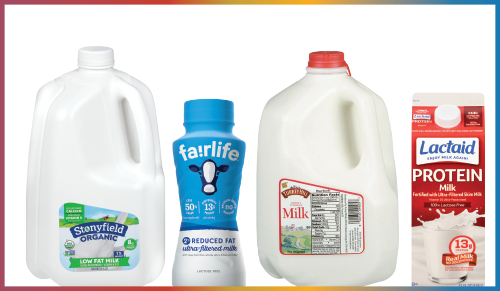By Donna Berry
July 6, 2021
A Century of
Fluid Milk Innovation


©bq-studio.ru – STOCK.ADOBE.COM
Sosland Publishing Company’s coverage of the food industry started out focusing on the grain, flour milling and baking industries for the first 50 years after its founding in 1922. During that same era, the meat-processing industry began a government-mandated transition away from being dominated by a handful of companies that developed an integrated infrastructure that made it almost impossible for outside cattle producers, feedlot operators, livestock transporters or processors to survive unless they were part of what was then, an insurmountable machine. There has always been an important link between the grain industries and commercial livestock production as feed quality and availability determines price, which is passed on to meat processors and the quality, availability and price they could demand for products on the market. A century ago, and still today, the constant has been the meat and poultry processing system’s reliance on grain-based feed to finish and sustain the herds and flocks needed to produce food for a dynamic, growing and migrating population. What has changed and continues evolving are the names in the game today versus 100 years ago.
Few if any of the pioneering companies, brands or descendants of the industry’s legendary leaders of 100 years ago are relevant or involved in today’s industry, evidence of the constant evolution and change that has made meat and poultry processing’s history a long and winding road dotted with plenty of peaks and valleys. Volatility has been a constant challenge for the meat processing industry as it has been for all segments of the food supply chain. Factors ranging from weather to labor issues to regulatory compliance to economic instability to international relations can have profound impacts on the degree of business success or failure any segment might experience.
Since Sosland’s founding, the company has expanded its portfolio of publications and websites to include a wider swath of food and beverage industries, including commercial and retail baking, global grain, meat and poultry, pet food, dairy and the supermarket perimeter. Looking closer at some of the names and companies that were prominent in the meat industry from a century ago sheds light on how the pieces complete the puzzle that is today’s industry.
Donna Berry
editor@sosland.com
The author is a contributing editor for Food Business News and a principal in the firm Dairy and Food Communications, Inc. Her website address is www.berryondairy.com.
You might also enjoy:
Looking ahead, producers, processors and retailers must appeal to evolving demographics.
Argentina-based company has made major inroads with HB4 wheat in Argentina, has sights set on Australia and the US
The pressures of regulation and consumer demand have led to significant advances in food science for the baking industry.
The US fluid milk industry has been one of the most highly regulated food and beverage sectors since rules were put in place at both the state and federal levels in the mid-1930s. It is no wonder why product innovation had been almost nonexistent until the late 1990s, when the low-fat and fat-free milk standards were eliminated from the Code of Federal Regulations.
“This meant that instead of different requirements to meet the standard of identity for ‘low-fat milk,’ the product would have to meet a combination of the regulatory definition for ‘low fat’ enacted after the Nutrition Labeling and Education Act of 1990 and the standard of identity for ‘milk,’” said Michelle Matto, consultant to the International Dairy Foods Association, Washington. “The compliance date was Jan. 1, 1998.”
This allowed for technologies to improve or enhance milk. It also opened the doors to functional ingredient addition.
When it comes to innovation with “the white stuff,” many of the advancements have gone unnoticed by consumers. Until the 21st century, the only visible progress had been in packaging.
“There have been many significant changes in the dairy industry in the past 100 years from the processing techniques, improvement of shelf life, manufacturing capabilities, packaging machines and containers,” said Ed Mullins, chief executive officer, Prairie Farms Dairy Inc., Edwardsville, Ill. “Distribution from home delivery to large mass retailers is the biggest retail change to note. Larger farms and consolidation of dairy processors has also occurred over the last century.”
In the early 1900s, dairy farmers were limited to what they could do by hand and with minimal equipment. They produced milk for their own immediate consumption and may have supplied neighbors and local businesses. It was delivered by cans and glass milk bottles, with the latter patented in 1878.
By this time farmers were aware of how thermal processing of milk deactivated spoilage microorganisms and enzymes. The glass bottles could be filled with pasteurized milk and sealed, an early example of extending shelf life. This allowed for daily home deliveries from the milk man.
The buzz during the Great Depression was that milk would soon be sold in paper containers, a concept consumers could not understand. As economies improved and houses were fitted with electricity, refrigerators were installed. This allowed for the storage of milk for longer periods, making larger containers attractive.
The first paper milk carton was introduced in 1933. It included a wax coating to make it waterproof. It came in varied sizes, with the paper gallon a very short-lived one, as the plastic “stapled” handle proved to be challenging to hold and pour.
“One of the biggest changes over the last 100 years is how milk gets distributed and into the homes of families,” said Rachel Kyllo, senior vice president, marketing and innovation, Dairy Farmers of America (DFA)-Dairy Brands, Kansas City, Kan. “In many ways, it’s come full circle, as the iconic milk man used to deliver right to the consumers’ doorstep. Then, we evolved into consumers picking up milk at their local grocery stores and even big box retailers. Now today, consumers are still picking up milk at the store, but we’re also back to making digital deliveries right to the consumers’ home.”
Lynne Bohan, spokesperson for HP Hood LLC, Lynnfield, Mass., said, “Some of the most significant changes in the milk category over the past century include the manufacturing and packaging technologies to improve quality and extend shelf life.”
One such example is the LightBlock Bottle Hood introduced in 1997. Research shows that when milk is exposed to light, it may cause off flavors to develop by oxidation. Hood’s LightBlock Bottle uses technology that prevents more than 97% of light from penetrating the bottle, which protects the milk from light, helping to maintain its fresh taste.
Since 1999, the company has been using ultra-filtration technology to remove 20% of the water from raw milk to produce its Simply Smart line of 1% and fat-free milks. The reduced water content improves mouthfeel by providing the perception of a higher-fat product. At the same time, this process also concentrates the protein and calcium contents.
“With Simply Smart Milk, you can taste a difference, all the taste without all the fat,” Ms. Bohan said.
Hood also produces the Lactaid brand of lactose-free milk. Lactase enzyme is added to the milk to break down the lactose, making it easier to digest. The availability and variety of lactose-free milks in the United States has been growing in the past 10 years as a way to keep lactose-sensitive and lactose-intolerant consumers drinking dairy rather than switching to non-dairy alternatives.
Prairie Farms, for example, was one of the first companies to offer lactose-free chocolate milk back in 2018. Lactose free is also a key attribute of fairlife milk, which debuted in 2014. The Chicago-based business, now owned by The Coca-Cola Co., Atlanta, developed an ultrafiltration process that removes the lactose and much of the sugar in milk, while concentrating the protein and calcium. It was the first multi-serve milk product to stray from the paper carton or typical plastic jug. The shrink sleeved and capped blow-molded recyclable bottle produced needed disruption in the multi-serve milk category, which had been experiencing steady declines since the 1970s.
“While milk is still purchased by more than 90% of households, there are so many beverage choices available to consumers today,” Ms. Kyllo said. “So, as an industry, we must continue to look for opportunities to drive product and packaging innovation that appeals to the wants and needs of today’s consumers.”
With a growing number of consumers seeking more options in their beverage choices, especially when it comes to milk, Ms. Kyllo and her DFA team decided to go where no other beverage manufacturer had gone yet. In late 2019, the cooperative developed Dairy Plus Milk Blends, a refrigerated beverage combining lactose-free dairy milk with almonds or oats. There are sweetened and unsweetened options, as well as a chocolate variety.
Another shakeup in the milk case came in 1997, when Dean Foods Co. answered the question that went unanswered for too long: How do you fit a milk carton into a car’s cup holder?
The company’s Milk Chug became the standard for single-serve fluid milk products. It was portable, resealable and round. The company also used an intermediate shelf-life processing technology to extend the typical 14- to 21-day shelf life of a traditional milk product to a 30- to 40-day shelf life while maintaining fresh milk flavor. The longer shelf life enabled the Milk Chug to be distributed into new markets and distribution channels, including national retail accounts.

Milk Chug brought overall category growth to markets where it was available, contrasting stagnant sales in markets where the product was not. The brand grew as distribution expanded, and was promising in the early years, with 1999 sales showing a 56% increase, from $64.1 million in 1998 to more than $100 million.
Unfortunately, the Milk Chug, later losing that name and going with the Dairy Pure brand, was not enough to keep the business healthy, and Dean Foods filed for bankruptcy in November 2019, dissolving by March 2020. At the time, Dean Foods was the United States’ largest milk producer. The bankruptcy served as a wakeup call to other milk processors to innovate and improve their marketing of milk.
The COVID-19 pandemic further got milk processors thinking. For the first time in nearly 40 years, retail milk sales were up, and not just by a percent or two.
“In 2020, the dairy department grew from being a $54 billion business to generating more than $61 billion, a $7 billion increase,” said Abrielle Backhaus, research coordinator, International Dairy Deli Bakery Association, Madison, Wis. “Milk and natural cheese remained the two sales powerhouses in December and all year.”
Milk added $1.4 billion in sales in 2020 versus the previous year, according to IRI, Chicago. As the country opens and eating out becomes more prevalent, retail milk sales have started to fall.
The dairy industry has started campaigning that milk may be the original superfood, as it delivers 13 nutrients, more than most beverages can claim without fortification. That may not be enough to slow the decline in sales, but it does provide a canvas for the addition of extra nutrition — think probiotics, plant sterols and prebiotic fiber — as well as creativity in flavor formulations, convenience packaging and even specialty claims, such as grass fed, organic and A2 proteins. The next 100 years likely will include many more transformations of the white stuff, with cellular cultured forms of animal-free dairy protein on the horizon.

